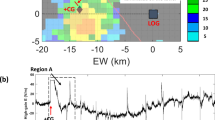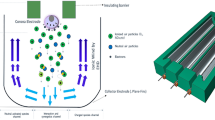Abstract
WITH a point-to-plane gap geometry, a visible (corona) discharge can occur at much lower values of applied gap voltage than those necessary to cause spark breakdown. Such a positive-point d.c. corona discharge in room air has been studied by recording the light emitted with an 11-stage photomultiplier. The output from the photomultiplier was delayed, amplified by ‘distributed’ amplifiers1, and displayed on a high-speed cathode ray oscilloscope. The time base of the oscilloscope was triggered by the output of light through a separate photomultiplier, distributed amplifier and thyratron trigger circuit.
This is a preview of subscription content, access via your institution
Access options
Subscribe to this journal
Receive 51 print issues and online access
$199.00 per year
only $3.90 per issue
Buy this article
- Purchase on SpringerLink
- Instant access to full article PDF
Prices may be subject to local taxes which are calculated during checkout
Similar content being viewed by others
References
Murphy, B., Wireless Engineer, 30, 39 (1953).
Amin, M. R., J. App. Phys., 25, 358 (1953).
Saxe, R. F., Nature, 173, 592 (1954).
English, W. N., Phys. Rev., 77, 850 (1950).
Gaunt, H. M., and Craggs, J. D., Nature, 167, 647 (1951).
Loeb, L. B., Phys. Rev., 91, 227 (1951).
Author information
Authors and Affiliations
Rights and permissions
About this article
Cite this article
MURPHY, B. Positive-Point D.C. Corona. Nature 176, 397–398 (1955). https://doi.org/10.1038/176397a0
Issue date:
DOI: https://doi.org/10.1038/176397a0
This article is cited by
-
A possible prebiotic peptide formation from glycinamide and related compounds
Origins of Life (1984)
-
Normal vibrations and conformations of glycine and its oligomers
Journal of Crystal and Molecular Structure (1973)



